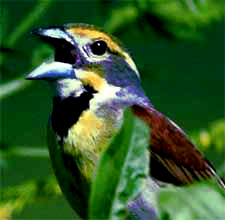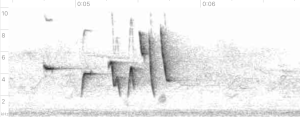 Hear the Dickcissel sing; photo by Steve Maslowski, US Fish & Wildlife Service
Hear the Dickcissel sing; photo by Steve Maslowski, US Fish & Wildlife ServiceOnce you've learned your local birds and begun making lists, probably you'll find yourself "bird listening" more than "bird watching." Especially during spring and summer, it's much, much easier to identify the various species by song than by trying to see every bird's field marks.
For this reason, good field guides describe in words as well as they can each species' song. Unfortunately, many of these descriptions are hard to interpret.
 Sonogram of Pale-footed Bush Warbler call; courtesy of 'Subsankar' via Wikimedia Commons
Sonogram of Pale-footed Bush Warbler call; courtesy of 'Subsankar' via Wikimedia CommonsSome field guides include "sonograms," or visual interpretations of the song, such at seen at the left. Once you match a sonogram to a song you are hearing or know, you start learning how to "hear in your mind" the song represented. Sonograms are helpful, but can take you just so far.
The best way to learn songs is to spot a bird with your eyes, and watch it as it sings often enough for your brain to fix the connection between the song and the bird. It's also a good idea to add in your notes your own descriptions of the songs, both in words and your own system of sonogram-like notations.
The Cornell Lab's "All About Birds" website sells an online Jump-start Your Birding-by-Ear Skills course. To hear songs of individual birds, do an Internet search on the words "hear song {bird's name}", such as "hear song eastern towhee," and probably you'll summon links to YouTube videos and to Internet pages with audio links to the species' song. In North American often you get one of at Cornell Lab's individual bird-species pages, which include a "listen" button.
Also on the web, check out Bird-sounds.net, and the USGS Bird Song Display List.